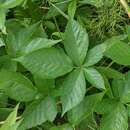Comprehensive Description
provided by North American Flora
Rubus vermontanus Blanchard, Am. Bot. 7: 1. 1904
Rubus nigricans Rob. & Fern. Man. 491. 1908. Not R, nigricans Rydb. 1901.
Stems biennial, at first erect, later decumbent, 1-2 m. long, more or less bristly with rather stiff spreading or reflexed bristles, terete or slightly angled; leaves of the turions 5-foliolate; stipules subulate, 1-1.5 cm. long; petioles and midveins glabrous, sparingly retrorsely bristly; leaflets dark-green, from oval or ovate to obovate or oblanceolate, 5-10 cm. long, thin, glabrous on both sides or slightly hairy on the veins beneath, sharply double-serrate, with lanceolate teeth, acuminate at the apex, acute or rounded at the base; petiolule of the median leaflet 1-2 cm. long, those of the other leaflets .short or none; floral branches 1-2 cm. long, slightly pubescent, unarmed or with a few bristles; leaves 3-foliolate; petioles 2-4 cm. long; leaflets lighter-green, obovate, subsessile or short-petiotuled, 2-6 cm. long; inflorescence a terminal elongate raceme; bracts lanceolate, 5-10 cm. long, the lower often cleft; peduncle and pedicels finely villouspub erulent, rarely if at all bristly, not glandular; sepals oblongovate, abruptly short-acuminate, villous-puberulent without, tomentose within; petals spatulate-obovate, 8-10 mm. long; fruit hemispheric, 1 cm. long, sour and seedy; drupelets glabrous, rather few.
Type locality: Southern Vermont. Distribution: Nova Scotia to Vermont.
- bibliographic citation
- Per Axel Rydberg. 1913. ROSACEAE (pars). North American flora. vol 22(5). New York Botanical Garden, New York, NY
Comprehensive Description
provided by North American Flora
Rubus vermontanus Blanchard, Am. Bot. 7:1. 1904
Rubus nigricans Rob. & Fern. Man. 491. 1908. Not R. nigricans Rydb. 1901.
Stems biennial, at first erect, later decumbent, 1-2 m. long, more or less bristly with rather stiff spreading or reflexed bristles, terete or slightly angled; leaves of the turions 5-f oliolate; stipules subulate, 1-1.5 cm. long; petioles and midveins glabrous, sparingly retrorsely bristly; leaflets dark-green, from oval or ovate to obovate or oblanceolate, 5-10 cm. long, thin, glabrous on both sides or slightly hairy on the veins beneath, sharply double-serrate, with lanceolate teeth, acuminate at the apex, acute or rounded at the base; petiolule of the median leaflet 1-2 cm. long, those of the other leaflets short or none; floral branches 1-2 cm. long, slightly pubescent, unarmed or with a few bristles; leaves 3-foliolate; petioles 2-4 cm. long; leaflets lighter-green, obovate, subsessile or short-petioltiled, 2-6 cm. long; inflorescence a terminal elongate raceme; bracts lanceolate, 5-10 cm. long, the lower often cleft; peduncle and pedicels finely villous-puberulent, rarely if at all bristly, not glandular; sepals oblongovate, abruptly short-acuminate, villous-puberulent without, tomentose within; petals spatu-
late-obovate, 8-10 mm. long; fruit hemispheric, 1 cm. long, sour and seedy; drupelets glabrous, rather few.
Type locality: Southern Vermont. Distribution: Nova Scotia to Vermont.
- bibliographic citation
- Per Axel Rydberg. 1913. ROSACEAE (pars). North American flora. vol 22(5). New York Botanical Garden, New York, NY
Rubus vermontanus: Brief Summary
provided by wikipedia EN
Rubus vermontanus is a North American species of bristleberry in section Setosi of the genus Rubus, a member of the rose family. It is found in eastern and central Canada (Québec, Ontario, Newfoundland, and all 3 Maritime Provinces) and the northeastern and north-central United States (Minnesota, Wisconsin, Michigan, Pennsylvania, New York, and all 6 New England States).
- license
- cc-by-sa-3.0
- copyright
- Wikipedia authors and editors

